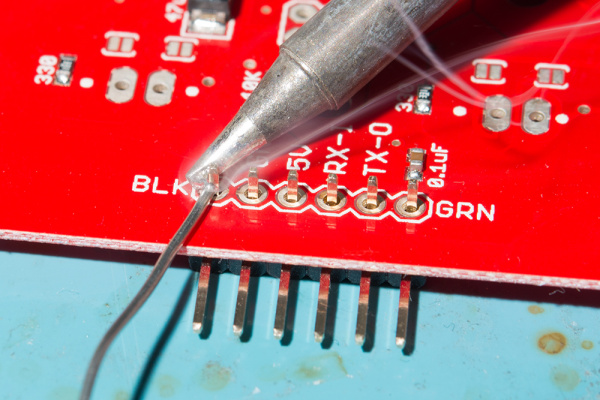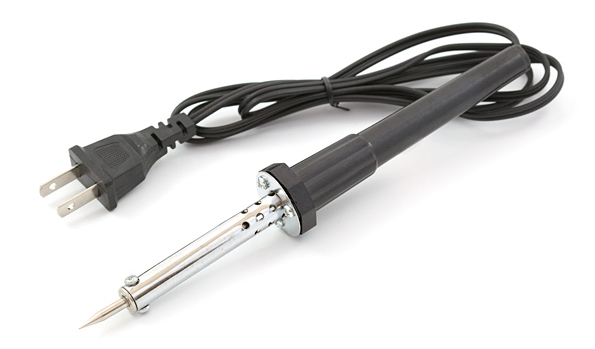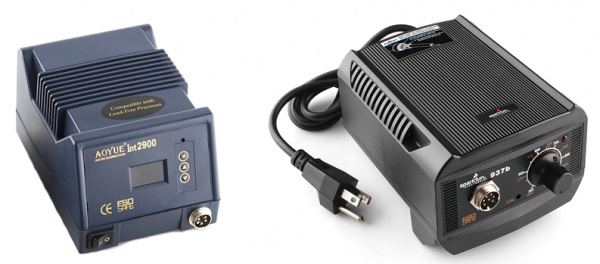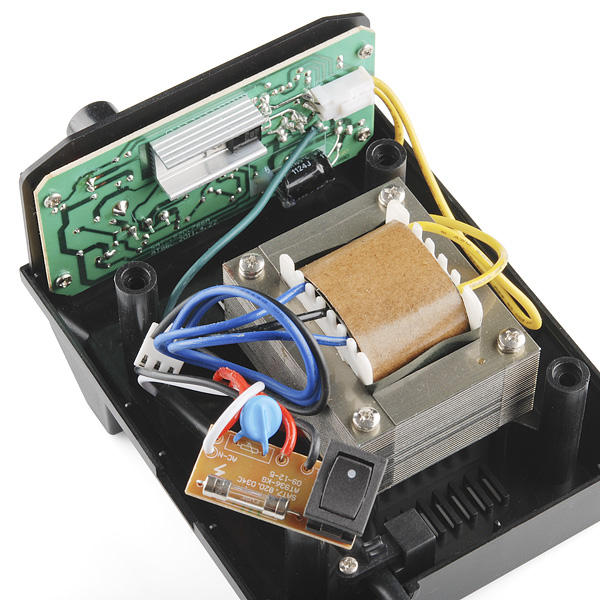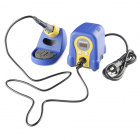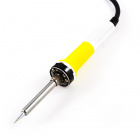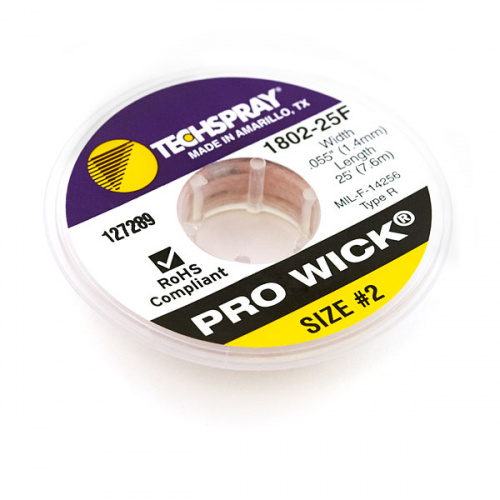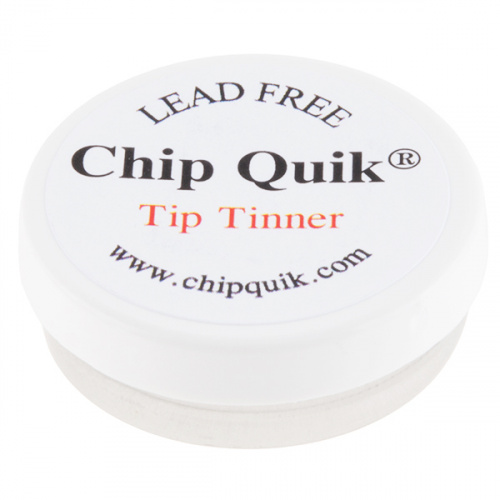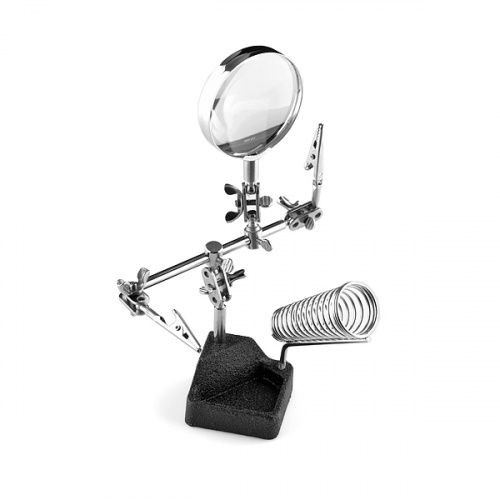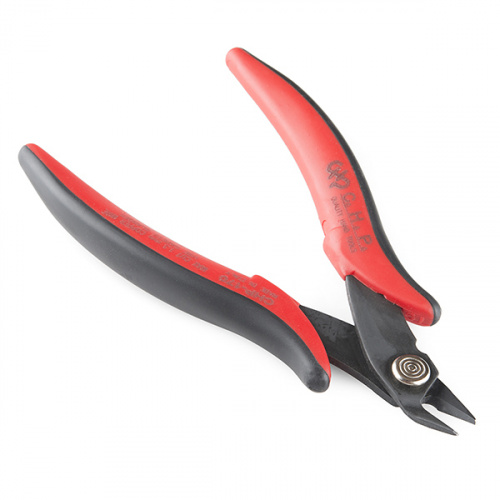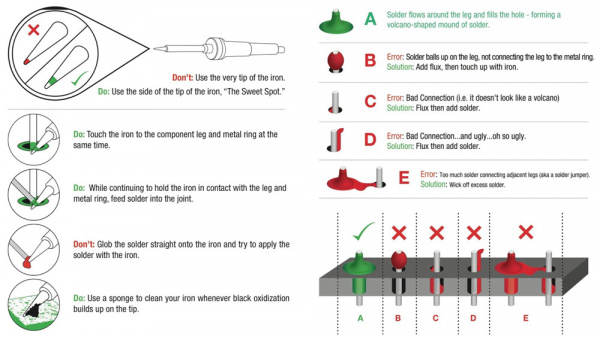How to Solder - Through-hole Soldering
Introduction
Soldering is one of the most fundamental skills needed to dabble in the world of electronics. The two go together like peas and carrots. And, although it is possible to learn about and build electronics without needing to pick up a soldering iron, you’ll soon discover that a whole new world is opened with this one simple skill. We here at SparkFun believe that soldering should be a skill in everyone’s arsenal. In a world of increasing technological surroundings, we believe it is important that people everywhere be able to not only understand the technologies they use everyday but also be able to build, alter, and fix them as well. Soldering is one of many skills that will empower you to do just that.
In this tutorial we will go over the basics of through-hole soldering – also known as plated through-hole soldering (PTH), discuss the tools needed, go over techniques for proper soldering, and show you where you can go from there. We will also discuss rework as it pertains to through-hole soldering and give you some tips and tricks that will make fixing any piece of electronics a breeze. This guide will be for beginners and experts alike. Whether you’ve never touched an iron before or are looking for a little refresher, this tutorial has a little something for everyone.
Suggested Reading
As stated earlier, you can learn about and build electronics without touching a soldering iron. If you would like to learn more about electronics theory before learning to solder, we recommend starting with some of these tutorials:
If you would like to know more about building circuits without needing to pick up a soldering iron, check out our solderless breadboard tutorial:
Lastly, we will be building upon some previous tutorials, so it is suggested that you read about and understand these subjects before moving forward in this tutorial:
What is Solder?
Before learning how to solder, it’s always wise to learn a little bit about solder, its history, and the terminology that will be used while discussing it.
Solder, as a word, can be used in two different ways. Solder, the noun, refers to the alloy (a substance composed of two or more metals) that typically comes as a long, thin wire in spools or tubes. Solder, the verb, means to join together two pieces of metal in what is called a solder joint. So, we solder with solder!
Solder wire sold as a spool (left) and in a tube (right). These come in both leaded and lead-free varieties.
Leaded vs. Lead-free Solder – A Brief History
One of the most important things to be aware of when it comes to solder is that, traditionally, solder was composed of mostly lead (Pb), tin (Sn), and a few other trace metals. This solder is known as leaded solder. As it has come to be known, lead is harmful to humans and can lead to lead poisoning when exposed to large amounts. Unfortunately, lead is also a very useful metal, and it was chosen as the go-to metal for soldering because of its low melting point and ability to create great solder joints.
With the adverse effects of leaded soldering known, some key individuals and countries decided it was best to not use leaded solder anymore. In 2006, the European Union adopted the Restriction of Hazardous Substances Directive (RoHS). This directive, stated simply, restricts the use of leaded solder (amongst other materials) in electronics and electrical equipment. With that, the use of lead-free solder became the norm in electronics manufacturing.
Lead-free solder is very similar to its leaded counterpart, except, as the name states, it contains no lead. Instead is is made up of mostly tin and other trace metals, such as silver and copper. This solder is usually marked with the RoHS symbol to let potential buyers know it conforms to the standard.
Choosing the Right Solder for the Job
When it comes to manufacturing electronics, it’s best to use lead-free solder to ensure the safety of your products. However, when it comes to you and your electronics, the choice of solder is yours to make. Many people still prefer the use of leaded solder on account of its superb ability to act as a joining agent. Still, others prefer safety over functionality and opt for the lead-free. SparkFun sells both varieties to allow individuals to make that choice for themselves.
Lead-free solder is not without its downfalls. As mentioned, lead was chosen because it performs the best in a situation such as soldering. When you take away the lead, you also take away some of the properties of solder that make it ideal for what it was intended – joining two pieces of metal. One such property is the melting point. Tin has a higher melting point than lead resulting in more heat needed to achieve flow. And, although tin gets the job done, it sometimes needs a little help. Many lead-free solder variants have what’s called a flux core. For now, just know that flux is a chemical agent that aids in the flowing of lead-free solder. While it is possible to use lead-free solder without flux, it makes it much easier to achieve the same effects as with leaded solder. Also, because of the added cost in making lead-free solder, it can sometimes be more expensive than leaded solder.
Aside from choosing leaded or lead-free solder, there are a number of other factors to consider when picking out solder. First, there are tons of other solder compositions out there aside from lead and tin. Check out the Wikipedia solder page for an extensive list of the different types. Second, solder comes in a variety of gauges, or widths. When working with small components, it’s often better to use a very thin piece of solder – the larger then number, the smaller the gauge. For large components, thicker wire is recommended. Last, solder comes in other forms besides wire. When getting into surface-mount soldering, you’ll see that solder paste is the form of choice. However, since this is a through-hole soldering tutorial, solder paste will not be discussed in detail.
Purchasing Solder
SparkFun offers many sizes of spools of solder in both leaded and lead-free varieties. Whether you just need enough for one project or are stocking up for the coming winter, SparkFun has what you need.
Now that you know how to choose the best solder for the job, let’s move on to tools and more terminology.
Soldering Irons
There are many tools that aid in soldering, but none are more important than the soldering iron. If nothing else, you need at least an iron and some solder to accomplish the task at hand. Soldering irons come in a variety of from factors and range from simple to complex, but they all function roughly the same. Here, we’ll discuss the parts of an iron and the different types of irons.
Soldering Iron Anatomy
Here are the basic parts that make up a soldering iron.
- Soldering Tips - No iron is complete without an iron tip. The tip is the part of the iron that heats up and allows solder to flow around the two components being joined. Although solder will stick to the tip when applied, a common misconception is that the tip transfers the solder. The tip actually transfers heat, raising the temperature of the metal components to the melting point of the solder, and the solder melts accordingly. Most irons give you the option to change your tip, should you need to replace an old tip or if you need to switch to a different style of tip. Tips come in a variety of sizes and shapes to accommodate any component.
Several types of tips. From left to right, the bevel tip (aka hoof tip), two conical tips with varying widths, and the chisel tip.
Changing the tip is a simple process that consists of either unscrewing the wand or simply pushing in and pulling out the tip
- Wand - The wand is the part of the iron that holds the tip. This is also the part that is handled by the user. Wands are usually made of a variety of insulating materials (such as rubber) to prevent the heat of the tip from transferring to the outside of the wand, but they also house wires and metal contacts that transfer heat from the base or outlet to the tip. This dual role of heating and preventing burns makes a high quality wand much appreciated.
Two varieties of wands. Notice how the tips screw into the wand allowing for interchangeability. Some wands have tips that simply push in and pull out without any attaching mechanism.
Some irons consist of just a wand that plugs into a wall outlet. These irons are as simple as they come, and they do not have any controls to vary the temperature. In these irons, the heating element is built directly into the wand.
A simple soldering iron that consists of just the wand. Some of these irons do not offer interchangeable tips.
- Base - The base of the soldering iron is the control box that allows the adjusting of temperatures. The wand attaches to the base and receives its heat from the electronics inside. There are analog bases, which have a dial that controls the temperature, and there are digital bases, which have buttons to set the temperature and a display that tells you the current temperature. Some bases even have extra features such as heat profiles that allow you to quickly change the amount of heat provided to the tip for soldering a variety of components.
Two variations of a soldering iron base. On the left, a digital base, complete with control buttons and a digital display. On the right, an analog base that uses a dial to control the temperature.
The base typically is comprised of a large transformer and several other control electronics that safely allow you to vary the heat of your tip.
The insides of a soldering iron base
- Stand (Cradle) - The iron stand (often referred to as a cradle) is what houses the iron when it is not in use. The stand may seem trivial, but leaving an unattended iron laying around on your desk or workbench is a potential hazard: it could burn you, or, worse, it could burn your desk and start a fire. Again, they can be as simple as a metal stand, or they can be complex, offering an auto-shutoff feature that reduces the temperature of the tip when the wand is placed in the cradle. This helps prevent the wearing of your tip over time.
Different types of iron cradles. Notice some allow for a regular sponge while others hold a brass sponge.
- Brass Sponge - As you solder, your tip will tend to oxidize, which means it will turn black and not want to accept solder. Especially with lead-free solder, there are impurities in the solder that tend to build up on the tip of your iron, which causes this oxidization. This is where the sponge comes in. Every so often you should give your tip a good cleaning by wiping off this build-up. Traditionally, an actual wet sponge was used to accomplish this. However, using a wet sponge can drastically reduce the lifespan of your tip. By wiping your tip on a cool, wet sponge, the tip tends to expand and contract from the change in temperature. This expansion and contraction will wear out your tip and can sometime cause a hole to develop in the side of the tip. Once a tip has a hole, it is no good for soldering. Thus, brass sponges have become the standard for tip cleaning. Brass sponges pull the excess solder from your tip while allowing the tip to maintain its current heat level. If you do not have a brass sponge, a regular sponge is better than nothing.
A brass sponge. If your iron stand doesn’t have a spot for a brass sponge, you can get one with its own base.
Purchasing a Soldering Iron
From soldering stations to cordless, SparkFun carries a soldering iron to fit your needs.
Our recommendations:
Soldering Accessories
Now that you know the ins and outs of a soldering iron, it’s time to discuss the other tools that will aid you on your soldering adventure.
- Solder Wick - is the eraser to soldering’s pencil. When dealing with issues such as jumpers or the removal of parts (desoldering), solder wick comes in very handy. Solder wick – aka desoldering braid – is comprised of thin copper wire braided together. Solder is soaked (wicked) up by the copper allowing you to “erase” extra globs of solder.
- Tip Tinner - is a chemical paste used to clean the tip of your soldering iron. It is composed of a mild acid that helps remove baked on residue (like when you accidentally melt your tip on a component) and helps prevent oxidation (the nasty black stuff) that accumulates on your soldering tip when not in use.
- Solder Vacuum (Solder Sucker) - is a great tool for removing solder left behind in through-holes when delsodering components. We’ll go over how to use this tool a little later in the tutorial.
- Flux Pen - Flux is a chemical agent that aids in the flowing of lead-free solder. Flux pens allow you to dab stubborn components with liquid flux to create better looking solder joints.
Other Suggested Tools
These tools aren’t necessary, but they sure do make soldering easier at times.
- Third Hand (Third Arm) - Third hands are great for holding PCBs, wires, and components in place while you solder.
- Flush Cutters - Cutters allow you to trim the legs of components you solder to the PCB.
- Safety Glasses - just in case any clipped leads go flying.
Soldering Your First Component
Let’s put all these tools into action. This first video will go over the basics of soldering your first component – headers!
Recap
It’s really that easy! Follow Dave’s simple rules to make every solder connection a good one.
- Be cautious when handling hot irons
- Use third hands or vices to hold boards while you solder
- Set your iron at a good medium heat (325-375 degrees C)
- If you see smoke coming from your solder, turn down the heat
- Tin your tip with solder before each connection to help prep the joint
- Use the side of the tip (aka the sweet spot), not the very tip of the iron
- Heat both the pad and the part you want to solder evenly and at the same time
- Pull the solder away, then the iron
- A good solder joint should look like a volcano or Hersey kiss, not a ball or clump
We’ve also put together this digram to help you better understand what makes a good solder joint.
Click for a larger image.
Advanced Techniques and Troubleshooting
Once you get the basics of creating good solder joints, it’s time to learn some of the more advanced PTH techniques that you can utilize. This video goes over using flux, removing solder jumpers, desoldering components, along with some other tips and tricks.
Here are some other tips for PTH soldering:
-
Desoldering can often be the best way to learn how to solder. There are many reasons to desolder a part: repair, upgrade, salvage, etc. Many of the techniques used in the video aid in the desoldering process.
-
There is another method of removing solder from through-holes that we refer to as the slap method.
-
If you’re ever unsure if the solder joint you created is making an electrical connection, you can use a multimeter to test for continuity.
Cleaning
When working with lead-free solder, flux tends to get everywhere, be it from the flux in the solder or from external flux applied by the user. Flux can corrode the PCB and components over time, thus it’s good to know how to clean your PCBs so they’re free of any flux residue. The simplest way to clean a board is to use a small brush (toothbrushes work great) and some isopropyl alcohol. If you are soldering more than a few boards, it may be necessary to clean them in batches. For this, we recommend a crock pot filled with distilled water. The distilled water keeps other impurities and contaminants away from your circuit.
It’s not 100% necessary to clean your board, however, it will increase the life of your circuit tremendously. For more information on PCB cleaning, click here.
